Luka: Thrusting and slicing are defenitely options with the broad axe.
Personally, I find it very likely that a two handed broad axe was used in a fast, cut-thrust-hook fashion rather than the mighty overhead swings usually envisioned.
There are a number of reasons for this; For one, the point of having a long, curved edge is to cut. Second, there is not really much point in making overhead swings against an unarmoured target, which was the norm viking age-high medevial scandinavia. And, finally, sparring experience sugests that if you lift your axe over your head, you will have a spear in the eye before you can even start to bring it down.
(The crecent shaped axes seen on continental europe in the middle ages are a even more pronounches cuting design.)
| Jean Thibodeau wrote: |
| I like the blade shape of this one from A & A , the slope should give a cleaving and slicing cut and the top " horn " agressive enough to be used as a point to a degree.
The scale of this one is more modest: Not small but not huge, but a larger version could be made: http://www.arms-n-armor.com/custom944.html |
I like the shape, I was thinking something similar to this, but bigger, with at least 4 foot haft.
| Elling Polden wrote: |
| Luka: Thrusting and slicing are defenitely options with the broad axe.
Personally, I find it very likely that a two handed broad axe was used in a fast, cut-thrust-hook fashion rather than the mighty overhead swings usually envisioned. There are a number of reasons for this; For one, the point of having a long, curved edge is to cut. Second, there is not really much point in making overhead swings against an unarmoured target, which was the norm viking age-high medevial scandinavia. And, finally, sparring experience sugests that if you lift your axe over your head, you will have a spear in the eye before you can even start to bring it down. (The crecent shaped axes seen on continental europe in the middle ages are a even more pronounches cuting design.) |
Yes, I have seen reenactors use these axes and I agree with all that leverage, short cuts and thrust are effective enough and not disrupting for your formation!
| Luka Borscak wrote: |
| Thanks guys! Quite a lot axes on those museum sites. ;)
Btw, totally off topic, but is this double fullered viking age sword??? It does look like it has 2 fullers... http://www.unimus.no/foto/#/P=search/S=%25F8k...I=37974KHM |
seems I have to correct myself Luka, that is indeed a blade with two fullers. not the entire length of the blade, but the first half or so has two fullers. or, well, at least the fuller has a ridge going down the middle, and this seems as high as the shoulders, and that should constitute two fullers i believe.
sorry about that, to quick.
| Audun Refsahl wrote: | ||
seems I have to correct myself Luka, that is indeed a blade with two fullers. not the entire length of the blade, but the first half or so has two fullers. or, well, at least the fuller has a ridge going down the middle, and this seems as high as the shoulders, and that should constitute two fullers i believe. sorry about that, to quick. |
No problem, I'm glad to hear this! Have you seen the sword in person or found the info somewhere?
I was shown a couple of pictures by a friend. we are building a new gallery on our groups webpage, and hopefully it will show up there in the near future.
I'm looking forward to that.
Btw, I found this picture of axe construction somewhere here and I wonder if this kind of construction is a norm for such axes. I'm especially interested in the construction of the edge. Is the reinforced part always made with these two parts welded on sides or did they also made edge and overlap the end of the body with it like in a sandwich but the edge is only one part of hardened steel split in the middle just enough to overlap the main body a bit?
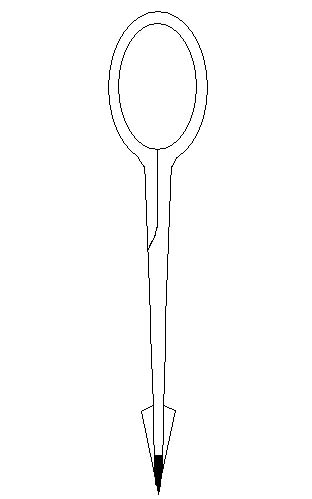
Btw, I found this picture of axe construction somewhere here and I wonder if this kind of construction is a norm for such axes. I'm especially interested in the construction of the edge. Is the reinforced part always made with these two parts welded on sides or did they also made edge and overlap the end of the body with it like in a sandwich but the edge is only one part of hardened steel split in the middle just enough to overlap the main body a bit?

The illustration shown does not give correct information on the shaping of the eye. The drawing shows the typical cross section on modern reproduction axes: a round or oval tube with a flat axe blade fixed to it. This should really be avoided if you are interested in being faithful to the elegant shape of the originals.
Original axes are much more elegant with an eye that is shaped like a 14th C heater shield: a flat top towards the neck of the axe and a pointed arch toward the cutting edge. This shape allows a good haft form and a good sturdy fit between head and haft.
If you want an authentic looking axe the shape of the eye is very important.
Note also the exact form and placing of the langets. They are very cleverly formed to create maximum security against twisting forces on the blade.
The first third of the blade below the eye grows gradually thinner from the maximum thickness of the eye. It is not an abrupt transition from eye to blade like in the illustration. You need much more thickness below the eye of the axe eye. This is then forged down gradually thinner towards the last two thirds of the blade. The edge may be constructed like in the drawing, but I suspect that the steel edge is more often a V that is wrapped around the thin iron blade.
The eye can perhaps be forge welded like in the drawing, but I expect it was common that the eye was a forged to shape U form that was pinched around the top of the blade. After welding the langets are drawn out to final shape, even though they may have been pre formed before welding.
Original axes are much more elegant with an eye that is shaped like a 14th C heater shield: a flat top towards the neck of the axe and a pointed arch toward the cutting edge. This shape allows a good haft form and a good sturdy fit between head and haft.
If you want an authentic looking axe the shape of the eye is very important.
Note also the exact form and placing of the langets. They are very cleverly formed to create maximum security against twisting forces on the blade.
The first third of the blade below the eye grows gradually thinner from the maximum thickness of the eye. It is not an abrupt transition from eye to blade like in the illustration. You need much more thickness below the eye of the axe eye. This is then forged down gradually thinner towards the last two thirds of the blade. The edge may be constructed like in the drawing, but I suspect that the steel edge is more often a V that is wrapped around the thin iron blade.
The eye can perhaps be forge welded like in the drawing, but I expect it was common that the eye was a forged to shape U form that was pinched around the top of the blade. After welding the langets are drawn out to final shape, even though they may have been pre formed before welding.
Peter - I (& likely many others) appreciate your time lately on axe topics. Compared to swords little detail available on axes. Thank you.
Thanks Peter!
Am I correct in understanding that the eye was most likely forged to rough shape then welded to the body, and then the hardened edge welded to the body - a 3 piece assembly? And have you seen any evidence to indicate the hardened edge may have been forged to a diamond cross section then fitted into a 'V" drifted into the body, then welded? Could the eye have been punched and drifted?
edit:
sorry Luka! I don't mean to hijack your thread!
Am I correct in understanding that the eye was most likely forged to rough shape then welded to the body, and then the hardened edge welded to the body - a 3 piece assembly? And have you seen any evidence to indicate the hardened edge may have been forged to a diamond cross section then fitted into a 'V" drifted into the body, then welded? Could the eye have been punched and drifted?
edit:
sorry Luka! I don't mean to hijack your thread!
Thanks very much Peter, I was hoping you would chime in and enlighten us! :)
No problem, this is very much on topic!
| R D Moore wrote: |
| Thanks Peter!
Am I correct in understanding that the eye was most likely forged to rough shape then welded to the body, and then the hardened edge welded to the body - a 3 piece assembly? And have you seen any evidence to indicate the hardened edge may have been forged to a diamond cross section then fitted into a 'V" drifted into the body, then welded? Could the eye have been punched and drifted? edit: sorry Luka! I don't mean to hijack your thread! |
No problem, this is very much on topic!
Construction methods varied.
I have seen some results of analysis of axes (but these papers are buried somewhere:I cannot quote them exactly. Sorry!) Tests did show that the set up of the billets that make up axes varied.
I cannot conjour from memory all the variations these tests revealed, but I do remember that an "upside down" U was welded over the upper part of the wedge of the blade itself. This I think was the norm even if other methods were used for construction of blade and edge.
There are also many subtle variations within the types and I do not pretend to have seen them all.
For the later types of axes I do not think that punching of the eye was ever used. For modern reconstructions it may still be a good way, as it will lead to dedicated forming of the volume in drawing out the blade. This can result in shapes just as those you see on viking age originals, provided you forge them just right.
The axes that are found in the danish bog finds dating to late roman iron age and early migration period do show a punched construction. These are very different in shape from viking age axes and outside this discussion, however.
Judging from original viking age axes I have seen and handled (some 50 or more?), they do not as a rule clearly show the welds from construction (they are very well made, with a keen eye for shape and function). Only rarely there are flaws that provide some insights to the construction.
The shape does provide some hints as to how you would most reasonably go about constructing them. The welded on V shaped edge steel is something I base from memory reading the article on viking axes. I do think other methods were used as well. A sandwich of three layers or a split blade with inserted steel are both viable methods as well.
There are two main types of form for these reinforced edges. On the later axes the ridge is very strongly defined. I think that these axes most often had a welded on V shaped edge steel wrapped over the iron blade. On those axes that have a somewhat softer or less dramatic ridge between blade and edge there may have been other types of construction used: they do not provide as clear clues to the construction judging from shape alone.
The main point I wanted to make in my post above is that the shape of reproductions of viking axes we see today are as a rule grossly simplified to a point where they do not really look like the originals at all. It is not just a case of aesthetics. If we change the shape too much we change function as well.
There is this overwhelming trend to form the axe by simply folding a sheet of metal into a tube and welding it to the body of the blade. Or to take a short length of iron pipe and arc weld it to a wedge of iron.
This is very far from the elegant form of the originals. Their shape is not just about more mature aesthetics, it is about maximizing resiliency of the material while minimizing mass. These axes are advanced in their design and made by skillful craftsmen with a keen eye for form and a deep understanding of materials. If the shortcuts we may make today changes the essence of the form we are left with something that does not have anything at all in common with the originals. Therefore we have to be faithful to form as a first priority and then as much as possible incorporate authentic materials and work methods.
We often come across arguments that axes and saxes were weapons of simple warriors and therefore supposed to be less expertly made than swords. This does not reflect the nature of surviving weapons. Even if the basic construction may involve fewer parts and less rich in ornaments, the actual shaping and making does not fall short in workmanship or awareness in design.
The image below that has been posted before on this thread shows well the drastic difference in form between the schematic construction drawing and original axes. Note how the blade changes thickness from eye section down to main body of blade. Also note the very specific shape of the eye. All originals vary in form but they all conform to this principle.
 Attachment: 42.54 KB
Attachment: 42.54 KB
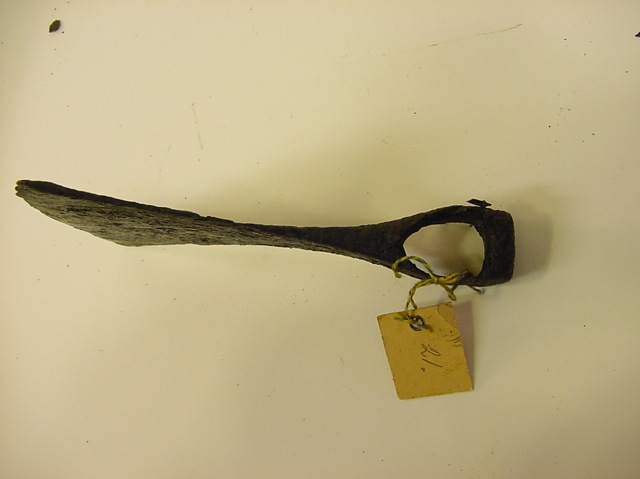
I have seen some results of analysis of axes (but these papers are buried somewhere:I cannot quote them exactly. Sorry!) Tests did show that the set up of the billets that make up axes varied.
I cannot conjour from memory all the variations these tests revealed, but I do remember that an "upside down" U was welded over the upper part of the wedge of the blade itself. This I think was the norm even if other methods were used for construction of blade and edge.
There are also many subtle variations within the types and I do not pretend to have seen them all.
For the later types of axes I do not think that punching of the eye was ever used. For modern reconstructions it may still be a good way, as it will lead to dedicated forming of the volume in drawing out the blade. This can result in shapes just as those you see on viking age originals, provided you forge them just right.
The axes that are found in the danish bog finds dating to late roman iron age and early migration period do show a punched construction. These are very different in shape from viking age axes and outside this discussion, however.
Judging from original viking age axes I have seen and handled (some 50 or more?), they do not as a rule clearly show the welds from construction (they are very well made, with a keen eye for shape and function). Only rarely there are flaws that provide some insights to the construction.
The shape does provide some hints as to how you would most reasonably go about constructing them. The welded on V shaped edge steel is something I base from memory reading the article on viking axes. I do think other methods were used as well. A sandwich of three layers or a split blade with inserted steel are both viable methods as well.
There are two main types of form for these reinforced edges. On the later axes the ridge is very strongly defined. I think that these axes most often had a welded on V shaped edge steel wrapped over the iron blade. On those axes that have a somewhat softer or less dramatic ridge between blade and edge there may have been other types of construction used: they do not provide as clear clues to the construction judging from shape alone.
The main point I wanted to make in my post above is that the shape of reproductions of viking axes we see today are as a rule grossly simplified to a point where they do not really look like the originals at all. It is not just a case of aesthetics. If we change the shape too much we change function as well.
There is this overwhelming trend to form the axe by simply folding a sheet of metal into a tube and welding it to the body of the blade. Or to take a short length of iron pipe and arc weld it to a wedge of iron.
This is very far from the elegant form of the originals. Their shape is not just about more mature aesthetics, it is about maximizing resiliency of the material while minimizing mass. These axes are advanced in their design and made by skillful craftsmen with a keen eye for form and a deep understanding of materials. If the shortcuts we may make today changes the essence of the form we are left with something that does not have anything at all in common with the originals. Therefore we have to be faithful to form as a first priority and then as much as possible incorporate authentic materials and work methods.
We often come across arguments that axes and saxes were weapons of simple warriors and therefore supposed to be less expertly made than swords. This does not reflect the nature of surviving weapons. Even if the basic construction may involve fewer parts and less rich in ornaments, the actual shaping and making does not fall short in workmanship or awareness in design.
The image below that has been posted before on this thread shows well the drastic difference in form between the schematic construction drawing and original axes. Note how the blade changes thickness from eye section down to main body of blade. Also note the very specific shape of the eye. All originals vary in form but they all conform to this principle.

So there are 2 welds between the socket shaped like U and the blade, looking basically like this?


Something like this perhaps?
 Attachment: 39.31 KB
Attachment: 39.31 KB
My best "etch-a-sketch" [ Download ]
My best "etch-a-sketch" [ Download ]
That looks most likely... I understand the edge I just wasn't sure about the socket.
Me neither. I'm assuming scarf joints would be required in some manner, and that makes the most sense to me. Difficult to answer without getting into a discussion on the theory and practice of forge welding during the period I suppose. I wonder what they used for flux? :)
RD, you are correct. overlap between eye and blade is a three layered sandwich where the overlap extend about the same width as the opening of the eye, or slightly more.
This forms a natural build up of thickness below the eye, that is forged down towards the thin part of the blade.
I should make a drawing I guess, but I am dead tired after 12 hours in the smithy...
This forms a natural build up of thickness below the eye, that is forged down towards the thin part of the blade.
I should make a drawing I guess, but I am dead tired after 12 hours in the smithy...
Here are some pictures of my Dane Axe forged by Dan Klug from http://whitehartforge.com/ . He hand forged on an old 5160 steel leaf spring using an old fashioned anvil, hammer, and coals, and nothing else! That was it!
This is how he does his forgings......guy even LOOKS like a viking!!
http://www.youtube.com/watch?v=v_hsqOAZO9U
Hardened to a Rockwell of 57 for the edge, and hand sharpened with a bastard file. The blade is a little over 13" long point to point. It is hafted on a 60" hickory pole.
It is one bad motha!
Hmmmm.....I would post some more pictures of it hafted, but it seems that they are slightly over the 250 KB size limit of this forum, and I don't know how to resize them.... oh well!
 Attachment: 126.5 KB
Attachment: 126.5 KB
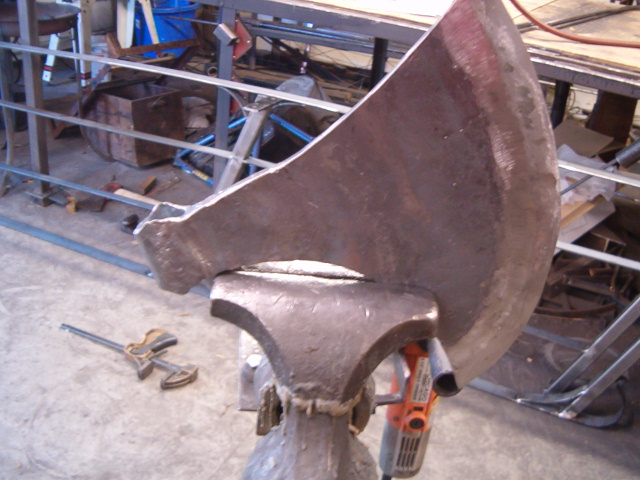
 Attachment: 118.79 KB
Attachment: 118.79 KB
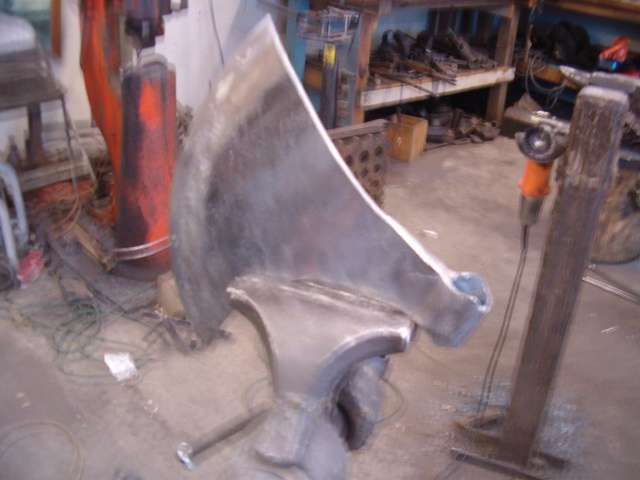
 Attachment: 92.19 KB
Attachment: 92.19 KB
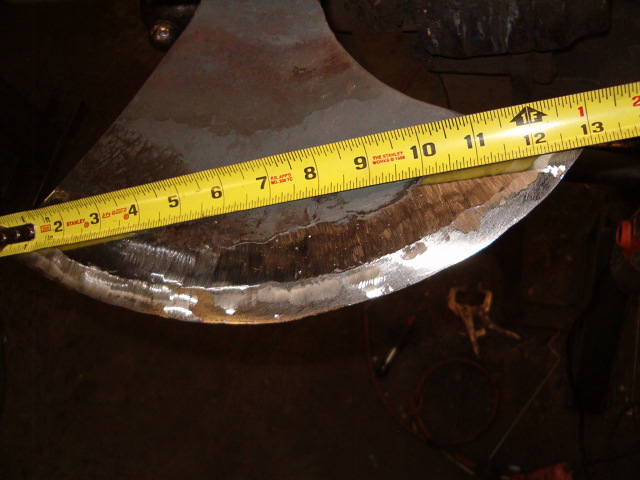
This is how he does his forgings......guy even LOOKS like a viking!!
http://www.youtube.com/watch?v=v_hsqOAZO9U
Hardened to a Rockwell of 57 for the edge, and hand sharpened with a bastard file. The blade is a little over 13" long point to point. It is hafted on a 60" hickory pole.
It is one bad motha!
Hmmmm.....I would post some more pictures of it hafted, but it seems that they are slightly over the 250 KB size limit of this forum, and I don't know how to resize them.... oh well!



Last edited by Michael Raymond on Wed 22 Sep, 2010 9:05 pm; edited 2 times in total
Though this axe may be hand-forged it seems to lack the historical socket shape and dimensions, not to mention forging technique, discussed in this thread.
We need to see more strictly historically designs, at least I do. ;)
I long to own a well executed and more historically correct danish or early medieval axe. It is great to read that folks like Peter seem to be investing some time in the research needed in this area.
We need to see more strictly historically designs, at least I do. ;)
I long to own a well executed and more historically correct danish or early medieval axe. It is great to read that folks like Peter seem to be investing some time in the research needed in this area.
Page 2 of 4
You cannot post new topics in this forumYou cannot reply to topics in this forum
You cannot edit your posts in this forum
You cannot delete your posts in this forum
You cannot vote in polls in this forum
You cannot attach files in this forum
You can download files in this forum
All contents © Copyright 2003-2006 myArmoury.com — All rights reserved
Discussion forums powered by phpBB © The phpBB Group
Switch to the Full-featured Version of the forum
Discussion forums powered by phpBB © The phpBB Group
Switch to the Full-featured Version of the forum